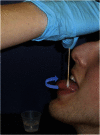Gustation assessment using the NIH Toolbox
- PMID: 23479539
- PMCID: PMC3662332
- DOI: 10.1212/WNL.0b013e3182872e38
Gustation assessment using the NIH Toolbox
Abstract
The NIH Toolbox for Assessment of Neurological and Behavioral Function (NIH Toolbox) is a set of brief measures for the assessment of cognitive function, emotional health, motor function, and sensory function for use in clinical trials and in epidemiologic and longitudinal studies. Gustatory perception is assessed as 1 of 6 areas of sensory function. A team of 11 scientists with expertise in taste perception selected 2 gustatory measures, 1 of which can be used in young pediatric populations. The measure selected for young pediatric populations assesses sucrose (sweet) taste preference and can also be used across the age span of 5 to 85 years. For adult populations, the selected measure is a regional test, which assesses variability in perceived intensity of quinine hydrochloride (bitter) when applied to the tongue tip as well as perceived with the whole mouth. The team also recommends the regional test for assessing other tastants, such as sodium chloride (salty). Validation studies have demonstrated that the measures modified for the NIH Toolbox correlate with more traditional assessments, and can identify known population differences in gustation.
Figures


References
-
- Tepper BJ, White EA, Koeliker Y, et al. Genetic variation in taste sensitivity to 6-n-propylthiouracil and its relationship to taste perception and food selection. Ann NY Acad Sci 2009;1170:126–139 - PubMed
-
- Smith DV, Davis BJ. Neural representation of taste. In: Finger TE, Silver WL, Restrepo D, editors. The Neurobiology of Taste and Smell, 2nd ed New York: Wiley-Liss; 2000:353–394
-
- Bartoshuk LM, Duffy VB, Green BG, et al. Valid across-group comparisons with labeled scales: the gLMS versus magnitude matching. Physiol Behav 2004;82:109–114 - PubMed
-
- Rawal S, Bartoshuk LM, Coldwell SE, et al. NIH Toolbox: proposed assessment of taste function and phenotype. Chem Senses 2010;35:A18 Abstract.
Publication types
MeSH terms
Substances
Grants and funding
- TW007768/TW/FIC NIH HHS/United States
- TW009071/TW/FIC NIH HHS/United States
- DC011393/DC/NIDCD NIH HHS/United States
- DC006760-05S2/DC/NIDCD NIH HHS/United States
- DC8613/DC/NIDCD NIH HHS/United States
- DC06760/DC/NIDCD NIH HHS/United States
- DE14254/DE/NIDCR NIH HHS/United States
- 1U01NS056975-01/NS/NINDS NIH HHS/United States
- HD37119/HD/NICHD NIH HHS/United States
- DC008613/DC/NIDCD NIH HHS/United States
- DC6369/DC/NIDCD NIH HHS/United States
- S8056/PHS HHS/United States
- R01 CA104883/CA/NCI NIH HHS/United States
- DC00283/DC/NIDCD NIH HHS/United States
- HD072307/HD/NICHD NIH HHS/United States
- DE016750/DE/NIDCR NIH HHS/United States
- P50 DC006760/DC/NIDCD NIH HHS/United States
- DC283/DC/NIDCD NIH HHS/United States
- R01HD054569-02NIDRR/HD/NICHD NIH HHS/United States
- U01 DK082342/DK/NIDDK NIH HHS/United States
- DE018768-S1/DE/NIDCR NIH HHS/United States
- CONS00827/PHS HHS/United States
- DC011287/DC/NIDCD NIH HHS/United States
- DC02995/DC/NIDCD NIH HHS/United States
- HHS-N-260-2006-00007-C/PHS HHS/United States
- HHSN265200423601C/NS/NINDS NIH HHS/United States
- R44 DC7291/DC/NIDCD NIH HHS/United States
- 2R44DC007291/DC/NIDCD NIH HHS/United States
- R01 HD037119/HD/NICHD NIH HHS/United States
LinkOut - more resources
Full Text Sources
Other Literature Sources
Medical
